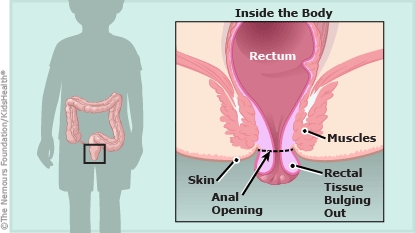A rectal prolapse is when rectal tissue bulges out from the anal opening. The rectal prolapse either got better on its own or your child's health care provider gently pushed it back in with a gloved finger.
Rectal prolapse can have different causes. In babies and kids, it's most often due to constipation (infrequent, hard poops) or diarrhea. When the cause isn't clear, health care providers might do tests or recommend that a child see a medical specialist.
The rectal prolapse may happen again. Follow these instructions to care for your child and manage a rectal prolapse if it happens again.


Depending on the cause of the rectal prolapse, your health care provider might recommend:
Follow your health care provider's advice for:

Your child has:

Your child:

What's the difference between a rectal prolapse and hemorrhoids? They can look the same, but in a rectal prolapse, it's the lining of the rectum that comes out of the anal opening. Hemorrhoids are swollen veins in the rectum or anus that come out of the anal opening.